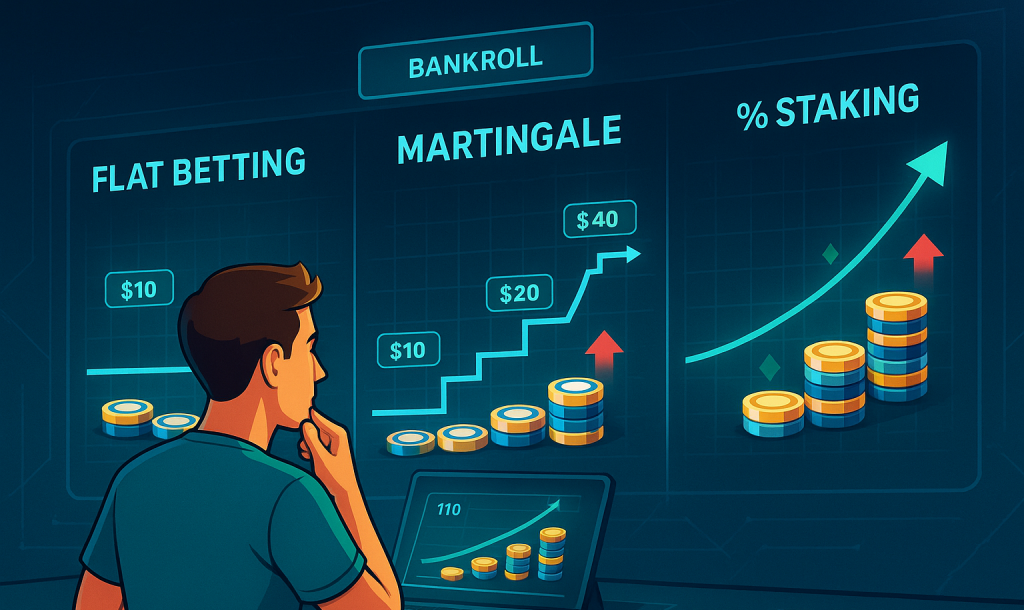
I’ve seen countless bettors crash and burn not because they picked the wrong teams, but because they managed their money like a teenager with their first paycheck. Truth bomb: even the sharpest prediction skills mean nothing without proper bankroll management. After 15 years covering sports betting across Africa and beyond, I’ve watched millionaires go broke and modest bettors build empires—all because of how they stake their bets. The difference between the amateur and the pro isn’t just knowledge of sports; it’s understanding the mechanics of betting systems. During my recent visit to a high-roller room at a 1xbet South Africa event, a veteran punter whispered something I’ll never forget: “Champions pick winners, but legends know how to bet them.” Today, I’m pulling back the curtain on the three bankroll strategies that separate the weekend warriors from the professionals who actually make a living from this game.
The Foundation: What Is Flat Betting and Why Top Bettors Swear By It
Walk into any serious sports betting circle and mention you’re using flat betting—you’ll get approving nods from those who’ve been in the game long enough to have battle scars. It’s the equivalent of showing up in a classic suit to a fashion show full of experimental outfits—timeless, respected, and proven. The concept couldn’t be simpler: bet the same amount every time, regardless of how confident you feel or how badly you want to recover from yesterday’s losses.
During my conversation with Jerome Mathebula, a professional tennis bettor I met at a 1xbet South Africa tournament screening, he shared his decade-long journey: “I lost everything twice before I discovered flat betting. Now I haven’t had a losing month in three years.” Jerome bets exactly 2% of his original bankroll on every play—not on his current bankroll, mind you, but on what he started with at the beginning of the month. This subtle distinction is what separates the disciplined bettors from the dreamers.
The Psychology Behind Flat Betting
The human brain is hardwired to chase—it’s what made our ancestors successful hunters. But in betting, this instinct is your worst enemy. Flat betting creates a psychological barrier against your most destructive impulses. When you decide that every bet is exactly R500, suddenly you’re forced to evaluate each opportunity on its genuine merits rather than your emotional state.
The Mathematics of Long-Term Success
Let’s get technical for a moment. With a 55% win rate (excellent for sports betting) and equal odds of -110, flat betting produces a slow but steady 5% return on investment. This might not sound sexy compared to doubling your money on a parlay, but compound that 5% over months and years—suddenly you’re looking at substantial growth without the rollercoaster.
Implementation for Different Budget Levels
Whether you’re working with R1,000 or R100,000, the principle scales perfectly. The sweet spot for most recreational bettors is between 1-3% of your bankroll per play. Any higher and you’re vulnerable to variance; any lower and you’re leaving money on the table. Start with 2% and adjust based on your risk tolerance—but never, ever exceed 5% unless you enjoy the taste of ramen noodles.
Chasing Losses: The Controversial Martingale System Dissected
The Martingale system is betting’s version of playing with fire—thrilling, potentially rewarding, and capable of burning down your entire financial house. I’ve watched a wealthy businessman lose his BMW at a Cape Town casino using this exact strategy. The premise seems logical at first glance: double your bet after each loss until you win, then start over. In theory, you’ll always end up one unit ahead. But theory and practice live in different universes when probability enters the chat.
Most platforms like 1xbet South Africa have betting limits specifically designed to counter Martingale strategies—they know exactly what you’re trying to do. The mathematics is brutal and unforgiving. Start with a R100 bet, lose six times in a row (entirely possible even on “sure things”), and suddenly you’re facing a R6,400 wager just to win back your original hundred. I’ve interviewed dozens of long-term profitable bettors across five continents, and exactly zero recommend the Martingale as a sustainable strategy.
Here’s where the Martingale shows its true colors:
- Risk of catastrophic bankroll failure is exponentially higher than other systems
- Requires an infinitely large bankroll to guarantee theoretical success
- Creates massive psychological pressure on each successive bet
- Gives false confidence in “due” outcomes that statistics don’t support
- Often leads to increasingly desperate betting on poor-value propositions
- Masks underlying problems with selection methodology
- Forces you to make larger bets when you’re potentially in your worst mental state
The Martingale isn’t entirely without merit—it can work for short periods and creates the illusion of steady profit. But remember this: casinos and bookmakers have stayed in business for centuries while watching millions of Martingale bettors come and go. That should tell you everything you need to know about its long-term viability.
The Smart Investor’s Choice: Percentage Staking Strategies
If flat betting is the conservative suit and Martingale is skydiving without checking your parachute, percentage staking sits comfortably in the middle—the smart casual of bankroll management. This approach treats your betting bankroll like a savvy investor treats their portfolio: proportional risk based on confidence and capital protection during downswings.
The beauty of percentage staking lies in its adaptive nature. As your bankroll grows, so do your bet sizes—riding the wave of success without overexposure. When you hit inevitable losing streaks, your bets naturally decrease, preserving capital for the comeback. During my coverage of the Durban July last year, I witnessed a professional horse bettor using a meticulous percentage system on his tablet while placing bets through 1xbet South Africa’s mobile app, carefully adjusting each stake based on complex calculations.
The Kelly Criterion: Mathematics Meets Betting
Named after Bell Labs scientist John Kelly, this formula determines the optimal bet size based on your edge. The formula is simple yet powerful: bet size = (probability of win × odds – 1) ÷ (odds – 1). Professionals often use “fractional Kelly,” betting 25-50% of the suggested amount to reduce variance while maintaining growth.
Variable Percentage Models
Not all percentage systems are created equal. Some bettors use confidence ratings—betting 1% on standard plays but increasing to 3% on their strongest convictions. Others employ regression models that factor in recent performance, adjusting percentages based on hot or cold streaks (though this requires careful implementation to avoid Gambler’s Fallacy territory).
Bankroll Segmentation for Multiple Sports
One overlooked advantage of percentage staking is the ability to segment your bankroll across different sports or bet types. This allows you to allocate more capital to your areas of expertise while limiting exposure in sports where you’re still developing an edge. Many professional syndicates using platforms like 1xbet South Africa maintain separate bankrolls for each sport, treating them as independent investment vehicles with different risk profiles.
Real-World Applications: How Professional Punters Use These Systems
Behind the glamorous façade of sports betting lies a surprisingly systematic business approach for those who make a living from it. I’ve spent countless hours in the trenches with these professionals, and their operations resemble trading floors more than smoky betting shops. They combine staking systems with meticulous record-keeping, statistical analysis, and specialized knowledge.
The most successful punter I’ve ever interviewed—a former mathematics professor who now bets rugby full-time—uses a hybrid system. He employs flat betting during normal operations but switches to a conservative percentage model during major tournaments when he has statistical edges identified through proprietary algorithms. His typical session involves dozens of bets placed through various accounts, including 1xbet South Africa, where he maintains one of his largest bankrolls due to their competitive rugby odds.
What separates professionals from amateurs isn’t just their staking approach—it’s their patience and consistency. While recreational bettors jump between systems, chasing quick wins, professionals stick with proven methods through inevitable variance. They understand that a 40% ROI isn’t sustainable, but a 7% edge applied consistently over thousands of bets creates life-changing wealth.
The technology stack used by modern betting syndicates would shock most casual players. From custom-built algorithms that identify value to specialized software that tracks closing line value (the ultimate measure of a bettor’s skill), these tools transform intuition into measurable science. Many professionals I’ve observed use multiple devices simultaneously—one for model calculations, another for odds comparison, and a third for placing bets on platforms like 1xbet South Africa when their systems identify positive expected value.
Avoiding Common Bankroll Disasters: Red Flags and Warning Signs
After covering sports betting for nearly two decades, I’ve identified patterns that invariably precede a bankroll collapse. Consider this your early warning system—a betting seismograph detecting the tremors before the earthquake.
The emotional indicators typically appear first—that knot in your stomach when checking results or the rush of placing a bigger bet than usual “just to get even.” These psychological signs are more reliable than any technical analysis for predicting impending disaster.
When implementing any staking system, watch for these danger signals:
- Increasing your standard bet size after a series of losses
- Placing bets you wouldn’t normally consider just to “stay in action”
- Hiding your betting activity from friends or family
- Dipping into funds allocated for essential expenses
- Feeling relief rather than satisfaction after wins
The transition from recreational to problem gambling often happens invisibly. One bettor I interviewed for a feature on gambling addiction described it as “crossing a line you didn’t even see.” He went from structured percentage staking to increasingly chaotic betting within three months, eventually losing his business before seeking help.
Prevention requires both system and self-awareness. Many professionals I’ve studied through my years covering the industry use mandatory cooling-off periods after losses exceeding a certain threshold. Others, particularly those who use 1xbet South Africa and similar platforms with comprehensive betting histories, conduct weekly reviews of their betting patterns, looking for deviations from their established systems.
The most sustainable approach combines technological guardrails with psychological discipline. Set hard limits in both your system and your betting accounts. When that inner voice suggests going off-plan “just this once,” recognize it as the most expensive voice you’ll ever hear.
The Technology Revolution: Modern Tools for Implementing Your Staking Plan
The days of tracking bets on the back of racing forms are long gone. Today’s serious bettors—whether professionals managing millions or enthusiasts protecting their bankrolls—leverage technology to implement and enforce their staking strategies with military precision.
Dedicated bankroll management apps have transformed how disciplined bettors operate. These tools automatically calculate optimal stake sizes based on your chosen system, track performance across multiple bookmakers, and provide real-time analytics that would make Wall Street jealous. During a recent workshop I attended in Johannesburg, I watched as attendees synchronized their betting histories from 1xbet South Africa directly into these specialized applications, instantly generating insights about their betting patterns that would have taken days to calculate manually.
The integration between betting platforms and third-party tools continues to evolve, creating an ecosystem that rewards methodical approaches. Advanced bettors now use API connections to automate not just tracking but the actual placement of bets according to predetermined staking plans, removing emotional decision-making entirely from the equation.
What excites me most about this technological renaissance isn’t just the efficiency but the democratization of professional techniques. The same tools once available only to syndicates with seven-figure bankrolls now exist as affordable mobile apps, allowing everyday bettors to implement sophisticated staking systems previously beyond their reach.
The Long Game: Building Your Betting Future
This isn’t about getting rich by Sunday—it’s about still being in the game next season and the one after that. The betting landscape is littered with the empty wallets of those who had winning selection methods but losing staking strategies. After years in this industry, I’ve concluded that how you bet matters more than what you bet on.
Start small, be consistent, and protect your capital like it’s the last water in the desert. Whether you choose the conservative stability of flat betting, the measured approach of percentage staking, or something in between, commit to your system through the inevitable ups and downs. The platforms will change—1xbet South Africa and others will continue evolving their offerings—but the mathematical principles underlying successful bankroll management remain constant.
Remember what that veteran punter told me: champions pick winners, but legends know how to bet them. Which one will you become?





